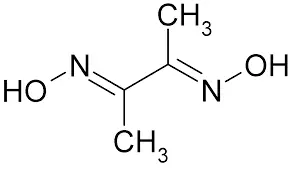Dimethylglyoxime Formula
Dimethylglyoxime is a powder-like chemical white in color. Its abbreviations are also dmgH for anionic form and dmgH2 for neutral form. Here H represents Hydrogen. DmgH2 is used in the study of chemical components like palladium or nickel in the laboratory. Coordination complexes of Dimethylglyoxime are very important and interesting for theoretical models for enzymes and as catalysts. This article will explain the Dimethylglyoxime formula with examples. Let us learn it!
 Source: en.wikipedia.org
Source: en.wikipedia.org
Dimethylglyoxime Formula
What is Dimethylglyoxime?
Dimethylglyoxime is a white chemical powder. It is soluble in methanol or in sodium hydroxide solution but very less in water. It is one of the first selective organic reagents applied in analytical chemistry. Also, it is very much sensitive and specific reagent for the nickel element.
Many derivatives of Dimethylglyoxime are synthesized and proposed. Although commonly it is useful as a reagent specific to nickel, Dimethylglyoxime actually allows the detection of other metal ions too. It works as a chelating agent which forms complexes with metals such as copper, nickel, and palladium.
This colorless solid is the dioxide derivative of the diketone butane-2,3-dione which is diacetyl. DmgH2 is useful in the analysis of palladium or nickel. Its coordination complexes are of theoretical interest as models for enzymes and catalysts both. We can prepare many related ligands from other diketones, such as benzil.
Dimethylglyoxime Formula
The formula for Dimethylglyoxime is:
Its expanded formula is:
Its other name is 2,3-Butanedione dioxide.
Some reaction of Dimethylglyoxime
- Nickel ion reacts with dimethylglyoxime and forms an insoluble red precipitate of nickel dimethylglyoxime.
- Dimethylglyoxime reacts with ferrous sulfate and ammonium hydroxide forms a complex compound of iron and ammonium sulfate and water.
Properties:
Its density is 1.37 gram per cubic cm. Its melting point is 240 to 241-degree C. Also instead of boiling it decomposes. It is very less soluble in water.
Uses of Dimethylglyoxime:
- It is widely useful in analytical chemistry as a selective precipitating reagent, detecting reagent and photometric reagent for nickel, palladium, platinum and some other metal ions.
- It is useful for the test for nickel release as well as for jewelry and for other objects that come in direct contact with the skin. In many countries, the dimethylglyoxime test is commercially available in various pharmacies and chemist shops.
- It is useful as a specific precipitant for nickel and palladium. Nickel precipitates like a bright red voluminous compound with from ammoniacal solution. Due to this a white palladium come down as a yellow compound from dilute hydrochloric acid solutions.
Solved Examples
Q.1: Calculate the molar mass of the compound Dimethylglyoxime:
Solution: Its molecular chemical formula is:
Its molecular weight is:
=
= 116.120 gram per mol.
Q.2: What are some health hazard issues related to compound Dimethylglyoxime.
Solution:
Fire Hazard: It has a direct fire hazard as it is a flammable solid. In the finely divided state, it has an increased risk of fire hazard. It may be easily ignited by sparks.
Explosion Hazard: It is fine dust explosive with air and thus has a direct explosion hazard. Also, the dust cloud can be ignited by a spark and may form a flammable/explosive vapor-air mixture causing indirect explosion hazard.
So, keep it away from the heat sources, ignition sources, oxidizing agents, reducing agents and strong acids.